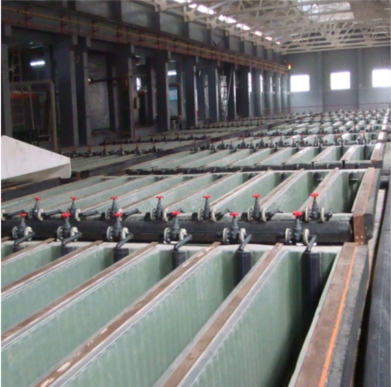The development of electrolytic antimony equipment has gone through a long process.
Antimony is not an essential element for life. It has long-term toxic and carcinogenic effects on organisms, and its toxicity will gradually weaken as the valence increases. In the production process, antimony is widely used in the production of alloys and semiconductors; antimony has a wide range of uses in medicine, electronics, glass, flame retardant and other fields.
Antimony electrolytic refining is a purification process in which the crude antimony anode is dissolved in the electrolyte and pure antimony is precipitated at the cathode. It is widely used in the purification of crude antimony and the extraction of precious metals. It can also be used for the treatment of crude antimony slag, antimony-containing slag and other impurity contents. In a mixed medium containing hydrogen fluoride, antimony fluoride and sulfuric acid, driven by direct current, the electrons of antimony are lost as ions, and the antimony ions are transferred to the cathode and reduced to metallic antimony. The impurities in it either enter the solution or remain in the anode mud.

Precipitation smelting: A smelting method first used in the UK, suitable for the smelting of antimony concentrate with an antimony content of more than 50%. Its essence is to use the different sulfur affinity between antimony and iron to replace antimony with iron at high temperature. This method has now been largely abandoned.
Volatilization smelting-reduction smelting: using the characteristics of antimony ore that is easy to oxidize and volatilize, antimony oxide is generated, antimony is separated from the gangue, and it is reduced to obtain metallic antimony. Among them, the volatilization method is a very critical step in the antimony smelting process and is also the most studied step. The gasification devices currently used include: rotary kiln, sintering machine, rotary kiln, blast furnace, vortex furnace, etc. The reduction smelting of antimony oxide is usually carried out in a reverberatory furnace at 1000℃, with anthracite and charcoal as reducing agents and sodium carbonate as flux. Conventional rotary kiln volatilization roasting: roasting temperature 1100℃, residence time 2-3h, recovery rate 90%. Heavy oil consumption is large and furnace agglomeration is serious. During the calcination process, the raw materials are violently stirred with the high-temperature air in the kiln, so as to achieve the purpose of fine grinding and drying the raw materials. The present invention has the characteristics of high desulfurization efficiency. Blast furnace volatilization roasting: Blast furnace volatilization roasting is the main process for antimony smelting in China. When the blast furnace smelts antimony ore, antimony is volatilized, oxidized, and gangue forms slag. The advantages of the present invention are: strong adaptability to raw materials, can handle sulfur-containing and oxidized ores; high volatilization rate, high recovery rate, high antimony oxygen grade; high production capacity, good working environment. Vortex furnace volatilization roasting: based on the vortex method for smelting copper. The advantages of the present invention: improve the intensity of combustion, reduce the consumption of fuel oil, improve the utilization efficiency of thermal energy, and achieve a high degree of automation.
Therefore, electrolytic antimony equipment plays an important role in industrial development.